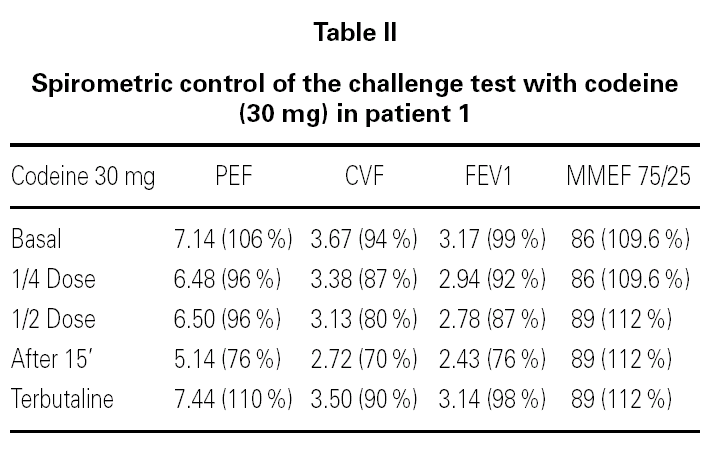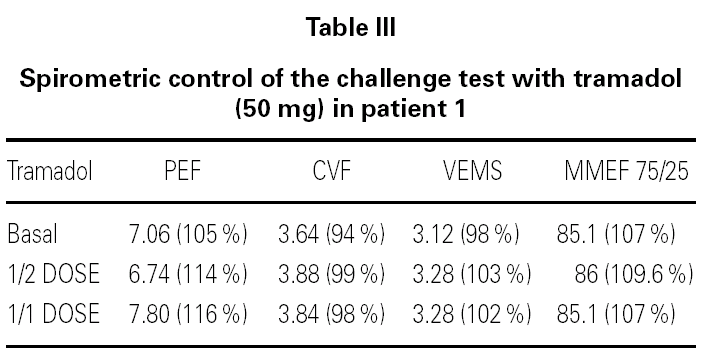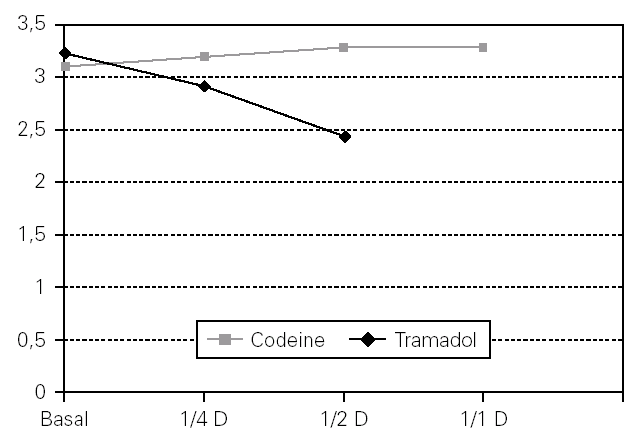INTRODUCTION
An increasing number of drugs help to improve the life of patients, particularly in relation to the management of pain. The most widely used agents are anti-inflammatory drugs that are already known to us and which may affect pathologies commonly seen in our practice, such as asthma and urticaria, in some patients.
The use of opioids is not unusual in analgesic treatment, and as we will see, these substances can also cause problems in such pathologies. The opioids are divided into several groups 1:
Morphine group: morphine, oxycodone, hydrocodone, heroine, noscapine, dextrometorphan, oxymorphone, levorphanol, tramadol, buprenorphine, codeine (Naloxone and Naltrexone as antagonists).
Piperidine: meperidine, loperamide, diphenoxylate, fentanyl, sufentanil, alfentanil, remifentanil.
Methadone group: methadone, levomethadyl, dextropropoxyphene.
These agents can produce frequent adverse reactions, such as 1: nausea, vomiting, sedation, respiratory depression, muscle rigidity, bradycardia or itching.
MATERIAL AND METHODS
We present three patients with clinical manifestations after codeine ingestion.
Case 1
A 27-year-old asthmatic woman sensitized to D. pteronyssinus and D. farinae, and in her fourth year of immunotherapy, appeared asymptomatic except for some respiratory infections. She suffered three episodes of dyspnea and wheezing related to the ingestion of paracetamol and codeine. She had tolerated paracetamol alone but had not taken codeine later. Skin prick-testing and IDR were performed with opioids. Controlled oral challenges with codeine and tramadol were carried out.
Case 2
A 32-year-old woman presented with rhinoconjunctivitis, sensitized to grass, Cupressus arizonica and animal dander. Previously she had neither cutaneous symptoms nor asthma.
She consulted 30 minutes after taking acetylsalicylic acid (ASA) and codeine for a respiratory infection, with a clinical picture of generalized acute urticaria that disappeared within a few hours with antihistamine medication. Skin prick-testing and IDR with opioids were performed. Posteriorly, controlled oral challenges with ASA, codeine and tramadol were carried out.
Case 3
A 25-year-old woman without previous cutaneous symptoms took codeine because of a cough; 15 minutes after the first dose, she developed generalized erythema, itching without symptoms on the palms and plantar surfaces. The skin symptoms disappeared within two hours without any treatment. This was her first-ever dose of an opioid, and she has not taken any such medication since.
Skin prick-testing and IDR were performed as in the previous case. Controlled oral challenging with codeine was not carried out. Direct testing with tramadol was performed.
Controls
At the time of the cutaneous tests, the latter were also carried out in 10 controls that had come into contact with opioids at some point in life, and also in 10 controls without such past contact.
RESULTS
Patient 1
The skin prick-testing and IDR results obtained are shown in table I.
Controlled oral challenge with paracetamol was carried out up to 1300 mg without any symptoms. Controlled oral challenge with codeine was also carried out, and the patient developed bronchospasm that improved with terbutaline (table II).
Controlled oral challenge with tramadol was well tolerated (table III).
To summarize, the patient developed bronchospasm in response to codeine, and was able to tolerate tramadol (fig. 1).
Figure 1.--Difference between challenge test to codeine and tramadol.
Patient 2
He skin prick-test and IDR results are the same that patient 1 (table I).
Controlled oral challenge showed complete tolerance of ASA, reaching the therapeutic dose. Controlled oral challenging with codeine 30 mg was carried out. The patient tolerated 1/8 of the dose without problems, though 40 minutes after ingesting 1/4 of the dose she developed itching and hives on the back. We therefore administered ebastine 20 mg. Fifty-five minutes later she presented generalized urticaria; dexchlorpheniramine and methylprednisolone were thus administered, after which the clinical picture resolved within 55 minutes.
Tryptase levels were determined, obtaining the following results:
Generalized urticaria: 15 μg/l
Two hours later: 9 μg/l
Baseline: 7 μg/l
Controlled oral challenge with tramadol 50 mg was carried out, without adverse effects.
Patient 3
The results obtained are similar of the other patients (table I). Controlled oral challenge with tramadol was carried out without incidents.
Controls
The following results were obtained:
Without contact:
Codeine: 8 Prick-test+
Morphine: 7 Prick-test+. All IDR positive up to 1/10 5; 9 positive up to 10 6
Tramadol: 2 Prick-test+. IDR 9+
Pethidine: 1 Prick-test+. IDR 10+
Fentanyl: 1 Prick-test+ IDR 0+
With contact:
Codeine: 9 Prick-test+
Morphine: 9 Prick-test+. IDR 9+ up to 1/10 6, 1 up to 1/10 5
Tramadol: 0 Prick-test+. IDR 10+
Pethidine: 2 Prick-test+. IDR 8+
Fentanyl: 1 prick-test+. IDR 8+
All patients were advised to use tramadol as analgesic and fentanyl and remifentanil as anesthetics.
DISCUSSION
The singularities of opioids deserve a brief review of their pharmacokinetic characteristics 1.
Codeine
This drug is a pure opioid agonist. It is used in application to moderate pain, cough and constipation. In some cases in Europe it is ineffective due to the high prevalence of fast extensive debrisoquine metabolizers.
Codeine can produce adverse effects requiring a differential diagnosis: cutaneous symptoms (itching, urticaria, rash, angioedema, erythema multiforme, erythema nodosum, occupational eczema). Respiratory: bronchospasm. Others: hypotension (when administered i.v.), pseudo-scarlatiniform fever.
The mechanisms of action underlying these clinical conditions may be: a) Hypersensitivity: one case has been described of IgE mediated response to morphine with cross-reactivity to codeine 2; b) Histamine release: highly potent; c) Ganglionic vasomotor depression and block: causes important hypotension.
To summarize, we have seen that the prick-test and IDR are of scant utility 3; indeed, such testing is used as positive control in France, in the same way in which histamine is used in Spain. Therefore, in those cases where the clinical history is insufficient, only controlled oral challenging can yield a diagnosis. In occupational contact eczema among workers who manipulate codeine, it is recommended to perform patch-tests with codeine phosphate a concentration of 0.1 % 4.
Morphine
This drug is a powerful analgesic, with high histamine-releasing potential that occasionally causes respiratory depression. Skin prick-testing and IDR are likewise of little help in this case, and the diagnosis must be based on the clinical findings or controlled oral challenge. Another case of IgE response to morphine has been reported in Spain, in addition to the case commented above with cross-reactivity to codeine.
There have also been reports of occupational cases with clinical conditions in which the symptoms are cutaneous or respiratory.
Tramadol
This drug is not a pure agonist, and its mechanism of action is partially mediated by its metabolite (o-demethyltramadol), which is a pure μ-agonist and possesses another still unknown mechanism. It acts upon the central nervous system binding to α2-adrenergic receptors, and also exerts some serotoninergic action. This is why the drug is contraindicated in patients receiving treatment with monoamine oxidase (MAO) inhibitors and in epilepsy.
Tramadol produces very little respiratory depression, and even in intubated patients with mechanical ventilation it neither reduces pO2 nor increases pCO2. It is the opioid recommended for asthma by the British Journal is of Anaestesia 5. In addition, tramadol is not a histamine-releasing drug.
It seems to be a good alternative for these patients, though only controlled oral challenge is able to confirm this.
Fentanyl and remifentanil
These substances are μ-agonists used as anesthetics and also to some extent as analgesics, because of their rapid metabolism. They are not histamine-releasing drugs, and constitute the anesthetics recommended for patients with pulmonary pathology 5.
In these cases fentanyl and remifentanil seem to be acceptable options in patients of this kind 5.
Pethidine-meperidine
This is the most powerful opioid formulation, as well as the one of the most intense histamine-releasing agents. A case of IgE-mediated pethidine hypersensitivity has been reported 6.
General Comments
In the study of opioids, adverse reactions, skin prick-testing and IDR are of scant value and can thus be omitted. The only way to diagnose these patients is by means of controlled oral challenge, and in highly suspicious cases we may search for specific IgE targeted to the opioid in question. Patch-testing is very useful in occupational contact eczema 4.
Many substances induce histamine release, including opioids. In these clinical situations PGD2 and LTC4 can be determined the corresponding values being 10-fold lower than in IgE-mediated reactions.
There are two types of mast cells: MTC (mostly in skin) and MT in the lungs 7. Opioids exert comparatively greater action upon MTC, which is why skin symptoms are the most common expression in these patients 7. Naloxone partially inhibits this action 7.
CONCLUSIONS
We have presented three patients with clinical pictures of asthma and urticaria following codeine ingestion, attributable to the histamine-releasing action of the drug. All of them tolerated tramadol without problems.
The most common of these adverse effects are not IgE-mediated. Resorting to opioids that do not mediate histamine release, such as tramadol, fentanyl and remifentanil, can solve the problem.
Skin prick-testing and IDR to opioids are of scant diagnostic utility, and the gold standard in these patients is controlled oral challenge.
Patch-tests in occupational contact eczema are usually used in workers suffering problems when manipulating morphine and codeine 4.
Correspondence:
L. Prieto-Lastra, MD
Servicio de Alergia
Hospital Universitario Puerta de Hierro
San Martín de Porres, 4. 28035 Madrid. Spain
E-mail: 652652167@amena.com












